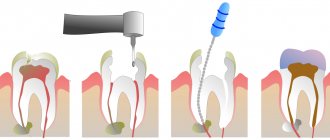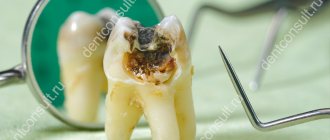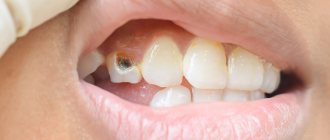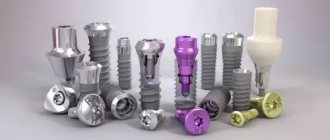Types of denture reinforcement
The type of reinforcement depends on the type of alloys used:
- In general dental practice, metal mesh is used to reinforce plastic dentures.
- The strength of acrylic bases is increased by using metal spacers, aramid threads, and fiberglass.
- The most popular reinforcing component is a mesh made of noble metals, which prevent the development of allergies and have good compatibility with other materials.
Dentists most often use meshes made of wire, perforated or cast plates:
- aramid threads,
- cellulose fiber,
- fiberglass,
- polyethylene,
- carbon mesh,
- quartz fibers,
- cast alloy gaskets,
- mesh made of gold and silver alloys.
Purpose of the method
The use of the technique is appropriate for plastic removable structures, since it is the thin layer of the base that is most often subject to destruction.
Additionally, the plastic base is prone to wear and thinning. To increase strength, the developers decided to use special meshes made of metal or fiberglass.
After introducing a metal thread into the base of the prosthesis, it becomes more durable and resistant to mechanical damage.
This procedure cannot be called mandatory during the manufacturing process, but often it is the reinforcement that helps prevent the base from crumbling in the event of damage.
The reinforced base perfectly holds the entire area of the structure, so its use becomes more convenient.
General requirements for reinforcement of removable dentures
When choosing material for reinforcement, the following factors must be taken into account:
- Biocompatibility (no allergy to it).
- Resistance to mechanical, chemical and bacterial influences.
- Durability, long service life.
- In general, the finished prosthetic structure must meet these requirements.
- Ideal fit to the gums.
- Accurately convey occlusion.
- Have a sufficient base thickness (about 2 mm).
- Do not have weakened zones in the polymer material, which can arise when the polymerization regime is violated.
- Acrylic teeth must be properly cured.
Indications and contraindications
When deciding to strengthen the prosthesis, the client must understand that he will not feel any additional discomfort. All threads or mesh are located inside the structure, which will not affect, for example, the condition of the mucous membranes.
The reinforcement procedure is carried out at the prosthetic stage and has its own indications:
- The patient has a narrowed oral fissure. In this situation, the prosthesis will have a longer service life, and when installing it, the likelihood of damage to the base becomes minimal.
- Prevention of fracture of the base of the structure.
- Features of the prosthetic bed. Due to the unique anatomical features, a conventional plastic prosthesis may not withstand the existing load, so it must be strengthened.
- Allergy to the plastic from which the base was made. To make adjustments, they resort to using alternative materials that do not cause an allergic reaction.
- Impaired diction, tactile and temperature sensations . This often happens due to acrylic dentures, since they cover most of the oral cavity.
- Frequent mechanical impact. The orthopedic structure will be further strengthened, which will allow increasing the load.
- Retention of unstable teeth , for example, due to periodontal disease or trauma.
- Large shrinkage. This design feature can lead to chafing of the mucous membrane. Reinforcement will help restore the tightness of the structure.
Contraindications to the use of orthopedic structures are established only by a doctor, based on the individuality of each client.
General requirements
Before deciding to install a reinforced prosthesis, you need to find out if you are allergic to metal or acrylic. It is an allergic reaction to some component of the metal that can worsen the condition.
It is important to consider the following points before installation:
- Allergy to acrylic compounds or precious metals.
- Increased tooth wear.
- Severely loose teeth.
- Low height of supporting teeth.
- Malocclusion.
If the patient has such characteristics of the oral cavity, then strengthening the structure may be prohibited.
It is important that the material meets the following qualities:
- possibility of high-quality processing;
- biocompatibility;
- high strength;
- hypoallergenic;
- aesthetics;
- minimal shrinkage.
Tooth restoration with filling
When the crown of a tooth has collapsed, what is more rational - modern prosthetics or restoration with durable filling materials?
If the molars are damaged, the doctor suggests restoring their functionality by installing a pin that strengthens the overall restoration. As a result, the desired effect will be achieved: you can chew again (but do not forget that overload is prohibited), the aesthetics of the molar will be quite acceptable. The tooth will look aesthetically pleasing - there are no external defects, the shape is even and anatomically justified.
Save a tooth with a pin or module
If a tooth breaks off and the natural crown is significantly damaged, a pin can again come to the rescue. With its help, you can strengthen the base and cover the tooth with an artificial crown or build it up with a polymer material.
The pins are made of both titanium and polymer; the alloy is biocompatible with body tissues and does not cause a negative reaction from tissues. The metal is durable - parts of the aircraft landing gear are made from it, so it can cope with chewing loads without problems. Installation of the structure is recommended when:
- Only parts of the real crown of the tooth remain (half or more is destroyed).
- The dentin is so damaged that the usual filling will not hold. Restoration with durable materials is required.
- It is necessary to restore the tooth under the covering of a prosthesis - permanent or removable.
The rod cannot be used if the root is destroyed (there is no support), if there is inflammatory gum disease, or if there is a cyst or granuloma under the problematic root.
Cerec modules
today it is much more effective than pins both in compatibility with the tooth and in strength.
And the main thing is the speed of restoration: any crown part of a tooth can be restored with the Cerec module in just 1-1.5 hours
.
The main condition for restoration is an intact tooth root. And, of course, the restrictions are the same as for pins: the presence of inflammation, cysts or granulomas under the problematic root is a direct contraindication. First, you need to eliminate these problems, and only then approach tooth restoration with the Cerec module.
Another interesting trend is the replacement of previously installed restoration pins with Cerec modules. This is due to the fact that pins still have their disadvantages, which can lead to tooth destruction, as shown in this video:
Tooth restoration with filling
Before starting the procedures, an examination is carried out - an x-ray or CT scan is performed. After making sure that there are no contraindications and the presence of a healthy root, the doctor decides to install a pin. When tooth damage is not critical - 30-40%, then restoration of the unit with filling compounds is completely justified:
- The pin is carefully mounted into the root canal, and cementation is performed.
- Next, the photopolymer composition is applied layer by layer. A filling is formed that replicates the physiologically justified tooth crown.
- The material is curing. The dentist polishes the surface, giving it a natural look.
In appearance, such a molar does not differ from neighboring teeth. But over time, the filling may change color.
If 2/3 of a tooth is damaged, installing a pin will help create a basis for strengthening the artificial crown. Filling is possible, but it is irrational - the tooth is fragile and will not withstand significant loads. Careless handling can provoke further breakdown of the unit, which can lead to complications. Therefore, in case of severe damage, placing a crown on a tooth is considered a reliable method of restoration.
How long do acrylic dentures last?
Dentures without reinforcement last approximately 3 – 5 years. If you properly care for it and handle it with care, its service life increases to 7–8 years.
If used incorrectly and poorly maintained, the product may not last even the required 3 years.
However, the service life of the product depends not only on its quality, but also on the rate at which the jaw bone decreases. Even if the structure does not break, it has to be replaced due to the fact that the bone tissue decreases in volume.
Acrylic plates on which artificial teeth are attached can last a very long time (8 – 10 years) under favorable conditions.
Advantages and disadvantages
When a client of a dental office decides to install a reinforced orthopedic structure, his attending physician must describe in detail all the pros and cons of such a procedure.
The absolute advantages are:
- high strength;
- durability;
- comfort;
- reliability;
- ease of cleaning;
- the ability to increase the mechanical load on the teeth;
- aesthetics.
If we talk about the disadvantages of such structures, they are as follows:
- increase in weight (when using metal mesh);
- long addiction;
- temporary change in diction;
- high thermal conductivity;
- high price for reinforcement with precious metals.
It is important that the prosthesis does not cause discomfort after installation.
Features of the classification of toothless jaws according to Oxman and other authors.
In this article we will discuss the cost of relining a removable denture.
Here https://www.vash-dentist.ru/protezirovanie/semnyie-p/zubnyie-na-prisoskah.html reviews about dentures with suction cups are offered.
Prices for plate dentures
| Dental prosthetics with complete removable plate dentures (1 jaw) | 35,000 rub. |
| Dental prosthetics with complete removable plate dentures (1 jaw) supported by implants on 4 locators | 80,000 rub. |
| Dental prosthetics with complete removable plate dentures (1 jaw) supported by implants on 4 ball-shaped abutments | 75,000 rub. |
| Dental prosthetics with complete removable plate dentures (1 jaw) supported by implants on a milled beam (without the cost of milling work) | 95,000 rub. |
| Dental prosthetics with complete removable plate dentures with reinforcement | 40,000 rub. |
| Prosthetics with partial removable lamellar dentures (1 jaw) | 25,000 rub. |
| Prosthetics with partial removable plate dentures for temporary replacement of 1-3 missing teeth (immediate denture) | 15,000 rub. |
| Prosthetics with partial removable laminar dentures for the temporary replacement of 4-6 missing teeth (immediate denture) | 20,000 rub. |
| Prosthetics with partial removable plate dentures made of acrylic-free materials | 40,000 rub. |
Why do dentures break?
If you use structures carefully, following all operating rules, then the likelihood of them breaking is extremely low. If the product does break, then the following factors contribute to this:
- Poor quality materials from which the base or fittings
- Increased load on the prosthesis
- Violation of the manufacturing technology of an orthopedic structure
Let's look at these factors in more detail.
Low quality of the prosthesis is determined by the following characteristics:
- The material from which the plate is made has insufficient tensile, impact, and bending strength
- The polymer ages over time
- The strength of the base decreases with water absorption during polymerization
Despite the fact that reinforcement significantly increases the strength of the prosthesis, such prostheses break for a number of reasons
Loads placed on the prosthesis cause failure in the following cases:
- The patient puts heavy and frequent loads on the structure
- Increased loads arise due to the individual characteristics of the patient’s jaw structure
- Complex jaw prosthetics were performed (the structure was installed after surgery to eliminate any pathology of the teeth or jaw)
Violations of prosthesis manufacturing technology are as follows:
- Foreign bodies get into the polymer mass
- Wax particles remain on the teeth, disrupting the shape of the structure.
- Base thickness varies from place to place
- Artificial teeth are soldered into the base incorrectly
- The fittings are installed incorrectly
- The central relationship of the jaws is incorrectly determined
- Violation of polymerization technology, for example, too rapid cooling
- Uncorrected bony protrusions
- Violation of occlusion (contact of the upper and lower units)
Description of the manufacturing process
Only a highly qualified dental technician should perform the reinforcement procedure, as this is a complex operation that requires appropriate knowledge and skills.
Before making a prosthesis, the doctor must examine the condition of the oral cavity. It is important to correctly calculate the possible loads on the teeth that perform a supporting function.
The entire reinforcement process consists of the following stages:
- After the plastering stage, the models begin to prepare the reinforcing mesh.
- Cut the mesh strip to the required length and width.
- The gypsum blank is adjusted to the desired shape along with the mesh.
- The finished model is sent to a photopolymerizer so that the mesh is cured. She should get tough.
- Installing limiters on the model. This stage is carried out so that the mesh is located in the thickness of the base of the structure; it is pressed tightly against the limiters.
- If necessary, pre-polymerization is carried out to avoid displacement during the process.
- Packing the base material into a cuvette. This process can be carried out both on the mesh and under it.
- The final polymerization stage of the plastic includes removing the prosthesis, grinding and polishing it.
Reinforcing components are introduced only into the base of the structure. Securing them to the beam portion will not help increase strength.
It is important to carry out reinforcement in the deepest places, where the prosthetic bed has a deep relief surface.
On average, the production of a reinforced prosthesis takes about 7 days.
In what cases is tooth reinforcement performed?
Doctors perform reinforcement of pulpless teeth that have been severely destroyed as a result of deep caries, pulpitis, periodontitis or due to trauma. The roots and coronal area can be subjected to this manipulation. Next, a composite material is built up or artificial crowns are installed, which accurately recreate the anatomical shape, color and functionality of a natural tooth.
On a note! The procedure can be performed in cases where the patient is diagnosed with inflammation of the periodontal tissues, leading to loosening of the roots. Teeth that are loose due to periodontitis or periodontal disease are strengthened with fiberglass threads, which keep them from falling out and correctly distribute the chewing load, but here it is more correct to talk not about reinforcement, but about splinting.
If one tooth is missing, the specialist can also offer you a reinforcement procedure with special materials in order to quickly restore the defect and restore the integrity of your smile. For example, with direct restorations, doctors build up the crown with a composite on fiberglass threads fixed between two supporting adjacent teeth. This will allow the patient to solve the problem of partial adentia in one visit to the clinic.










